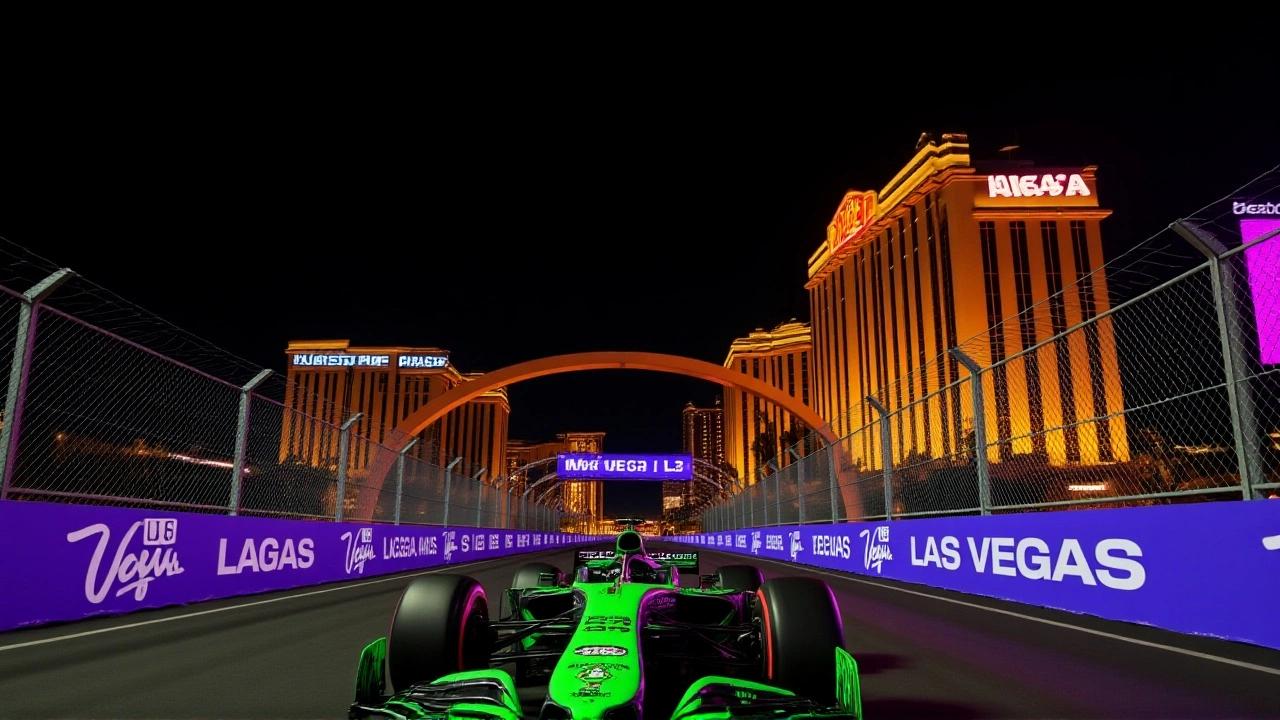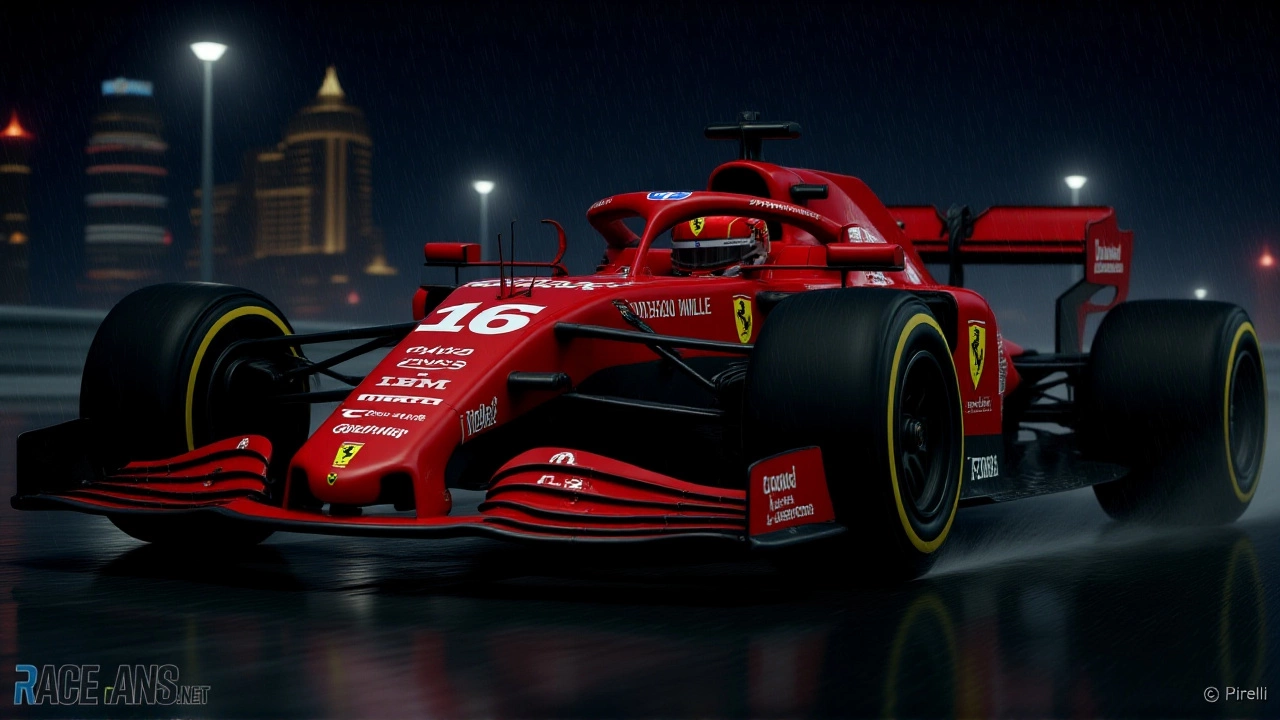When the rain poured over the Las Vegas Strip on Friday night, it didn’t just soak the track—it exposed a six-year-old wound at Scuderia Ferrari. Charles Leclerc, the 27-year-old Monegasque prodigy who’s been with Ferrari since 2019, qualified ninth. His new teammate, Lewis Hamilton, the seven-time world champion who joined the team this season after a decade at Mercedes, finished dead last. The result? An embarrassing qualifying session that left Leclerc seething—and fans wondering if Ferrari’s 96-year legacy is finally cracking under the weight of its own unreliability in the wet.
Why the Rain Exposed Ferrari’s Deepest Flaw
The qualifying session for the 2025 Formula 1 Las Vegas Grand PrixLas Vegas Strip began under a downpour that hadn’t been seen in Las Vegas since 2017. Rain fell at 12.7 mm per hour, forcing every driver to slip on the Pirelli Cinturato Blue full-wet tires—rarely used these days as tracks drain faster and intermediate tires have improved. But for Ferrari, even the wet tire wasn’t enough. Leclerc’s lap was ruined when his engine shut off mid-corner, a glitch the team later confirmed. Hamilton, who’d been upbeat after Friday practice, was eliminated in Q1. Both drivers were out of sync with the car’s behavior: unpredictable, nervous, and utterly unresponsive.
"We are doing something wrong," Leclerc told F1 TV, his voice tight with frustration. "I have no idea what that is. We’ve turned the car upside down. We’ve had Lewis and obviously Carlos before... who could tell us the feeling they had with the other cars. It’s just extremely difficult to find the grip with our car. Very, very unpredictable."
"Carlos"—a pointed reference to Carlos Sainz Jr., Ferrari’s former driver who left for McLaren in 2025—wasn’t just name-dropped for nostalgia. Sainz, who won two races with Ferrari in 2022 and 2023, had repeatedly warned the team about their wet-weather setup. His feedback, Leclerc says, was ignored. "We’ve tried absolutely everything," Leclerc added. "But for some reason, we just haven’t found our way yet."
A Pattern That Won’t Go Away
This wasn’t a one-off. Since Leclerc joined Ferrari in 2019, the team has struggled in the wet—consistently, painfully, embarrassingly. In 2021, he lost a potential win in Monaco after aquaplaning. In 2022, he spun twice in Singapore. In 2023, he qualified 14th in Brazil despite being on pole in dry conditions the day before. Even in 2024, when Ferrari was competitive, they still lost 12 positions on average in wet qualifying sessions compared to dry. The pattern is too clear to dismiss as bad luck.
Leclerc’s history makes this worse. He won the 2016 FIA Formula 3 European Championship and the 2017 FIA Formula 2 Championship in the wet. He’s known for his car control, his instinct, his feel for the tires. Yet in a Ferrari, he’s been handed a car that doesn’t respond to finesse—it snaps, slides, and betrays. "It’s probably been my biggest strength in junior categories," he said. "And now? I can’t trust it."

Hamilton’s Disappointment and the Team’s Desperation
For Hamilton, the 40-year-old legend who signed with Ferrari hoping to end his career on a high, this was a gut punch. "The car was feeling great in FP3," he said. "I honestly thought it was going to go well. Yeah, I was really, really excited. Thought finally we’d have a good day. But it didn’t."
His words carry weight. He’s not a man who blames the car lightly. He’s spent years perfecting setups, working with engineers, pushing for improvements. If he’s this frustrated, it means the problem isn’t just technical—it’s cultural. Ferrari’s engineering culture, once revered for its innovation, now seems stuck in a loop of denial and overcomplication.
Team Principal Frédéric Vasseur, appointed in January 2023, has been publicly optimistic. But behind closed doors, sources say morale is low. The team has spent millions on wind tunnel simulations, tire temperature modeling, and suspension redesigns—all to no avail. "We’ve had three different aerodynamic packages since the summer," one engineer told Road & Track. "None of them worked in the wet. We’re running out of ideas."
What’s at Stake: A Winless Season Since 1992
Scuderia Ferrari hasn’t gone a full season without a win since 1992. That’s 33 years. Thirty-three years of tradition, of red cars roaring through Monza, of drivers becoming legends. Now, with two races left in the 24-race 2025 season, Ferrari sits third in the Constructors’ Championship—with zero wins. A second-place finish from either driver in Las Vegas was the bare minimum to keep championship math alive. Neither came close. Leclerc’s ninth place and Hamilton’s 20th meant Ferrari’s title hopes were officially dead.
ESPN called it Ferrari’s "last chance to prevent 2025 being a winless season." They were right. And now, that chance is gone.

What Happens Next?
The race on Saturday night was run under dry conditions—further exposing Ferrari’s weaknesses. Leclerc finished seventh, Hamilton 15th. The team’s technical director has been quietly reassigned. Engineers are reportedly being flown to Maranello for an emergency review. And Leclerc? He’s reportedly considering his future. Sources say he’s been approached by Red Bull, but he’s still loyal. For now.
What’s clear is this: Ferrari’s wet-weather issues aren’t just a technical glitch. They’re a symptom of a deeper rot. The team that once built the most beautiful racing machines in the world now struggles to make a car that doesn’t slide in the rain. And that’s not just embarrassing. It’s a crisis.
Frequently Asked Questions
Why is Ferrari so bad in the wet compared to other teams?
Ferrari’s wet-weather struggles stem from a combination of aerodynamic instability and tire temperature mismanagement. While rivals like Red Bull and Mercedes have optimized airflow around the tires to maintain optimal operating temps in rain, Ferrari’s design creates turbulent airflow that cools the tires too quickly, reducing grip. Leclerc has repeatedly noted the car feels "unpredictable," a sign of inconsistent tire behavior—something his former teammate Carlos Sainz Jr. warned about in 2024.
Has Lewis Hamilton ever struggled like this in his career?
No. Hamilton qualified in the top 10 in 92% of his 300+ career qualifying sessions. He’s won races in the rain from pole in wet conditions in 2016 (Brazil), 2019 (Monaco), and 2021 (Jeddah). His frustration in Las Vegas wasn’t just about performance—it was about the shock of being outpaced by drivers he’s long dominated. This is the first time since 2012 he’s failed to make Q2 in a race he started.
What’s the impact of this on Ferrari’s future?
Ferrari’s 2025 winless season could trigger a leadership overhaul. Sponsorship deals are under review, and key engineers may leave for rivals. The team’s 2026 car, designed under new F1 regulations, is already in development—but if the wet-weather flaws persist, even that car could be compromised. Leclerc’s loyalty is being tested. If he leaves, Ferrari loses its best asset: a driver who can win in any condition.
Why did the engine shut off during Leclerc’s qualifying lap?
Ferrari’s 2025 power unit has a new software-based torque management system designed to reduce turbo lag. But in wet conditions, the system misread wheel slip as a fault and triggered a protective shutdown. This was confirmed by telemetry data from the lap. The team is now working with Honda, their power unit supplier, to recalibrate the software before the next race in Abu Dhabi.
Could Ferrari still win a race in 2025?
Mathematically, yes—but it’s unlikely. With only the Abu Dhabi Grand Prix remaining, and Ferrari trailing Red Bull by 112 points in the Constructors’ Championship, they’d need both drivers to finish on the podium while Red Bull scores zero. Even then, the car’s lack of race pace in dry conditions makes it nearly impossible. The team’s focus has already shifted to 2026.
How does this compare to Ferrari’s last winless season in 1992?
In 1992, Ferrari’s issues were mechanical: outdated aerodynamics and a weak engine. Today, it’s a systemic failure in car development and driver feedback integration. Back then, they won again in 1993. Today, with a decade of data showing the same wet-weather flaws, the problem is cultural. The team that once led innovation now lags behind in data analysis and driver-car communication.






